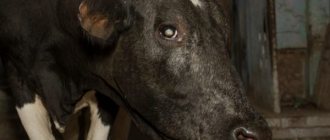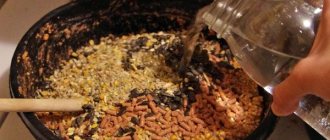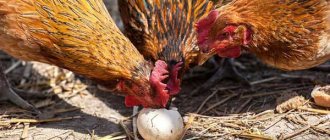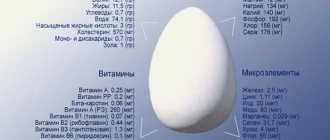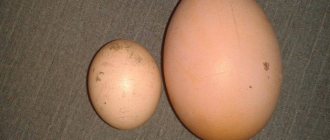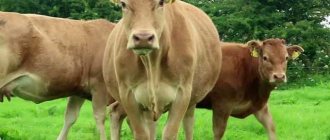Symptoms accompanying the death of chickens
Beginning poultry keepers need to remember:
1. Increase in temperature. A sign that the chicken may be infected and should be isolated from the general population. High temperature can be noticed immediately. The chicken or adult becomes lethargic and drowsy. Most of the time he sits with his wings down and his eyes closed.
2. The presence of redness in the mucous membranes of the eyes, the nasal cavity and mouth are clogged with mucus. The hen tries to clear her throat in a hoarse voice. Shakes his head, tries to clean his beak on the feathers. The feather cover is ruffled and very dirty.
3. Almost all infectious diseases are accompanied by indigestion (diarrhea). At these moments, sick individuals lose their appetite, the back part (down with feathers) is too dirty and sparse.
If sick chickens are identified in the livestock? This is a direct threat to neighbors who also have birds.
It must be taken into account that some types of chicken diseases can also be dangerous for their owners. Therefore, you should avoid eating meat and eggs from chickens that will be killed. It is better to burn them away from the poultry house.
Diagnosis of possible problems
It doesn’t matter what caused the mortality on the farm, the main thing is that the cause is detected in a timely manner, after which veterinarians should be notified, who can provide the owner with full advice on the problem that has arisen. The most win-win option here is preventive veterinary examinations of the entire livestock, especially if symptoms appear insignificant at first glance. The owner must monitor his birds for any warning signs, such as:
recommended articles:
- How to keep turkeys in winter?
- Winter births in rabbits
- poor feed consumption;
- appearance of lameness;
- refusal of water;
- bad dream.
Not always all of the listed signs may indicate a disease that will end in death, but it is always better to be safe.
A veterinary examination involves taking samples, for example, droppings, which can be used to determine the cause of the laying hen’s illness. Of course, you will have to pay for such a service, and often this problem becomes the main one in refusing veterinary services. Here the owner must decide what is more important: paying for the services of a specialist or waiting for a massive death of chickens, which will lead to large losses.
Veterinarian with chickens
Another advantage of inviting a veterinary specialist is that only a doctor can make the correct diagnosis, for example, of a serious infectious disease while it is just developing. If the owner notices deviations in the behavior of his birds, he is unlikely to know what actions need to be taken next.
Once the diagnosis has been made, it is necessary to follow all the specialist’s recommendations, no matter whether they concern adult livestock or chickens. Even the most insignificant symptom can become a harbinger of a serious illness, and therefore delays are extremely undesirable.
Chickens are dying en masse: infectious and parasitic diseases
Not only chickens, but also adult chickens die from infections. The most common infectious diseases of birds are pasteurellosis, coccidiosis, etc. Every poultry farmer should know how these diseases manifest themselves in order to respond in time and save the livestock.
Pasteurellosis
The causative agent is the bacterium Pasteurella. It is highly virulent and resistant to external factors. The incubation period lasts from several hours to 2 days. Bacteria enter the body of birds mainly through the respiratory system. Less commonly, infection occurs through nutrition or through damaged skin. Pasteurellosis often occurs in an acute form, with mortality reaching 90–100%.
- depressed state, lethargy, drowsiness;
- birds lose their appetite;
- breathing is difficult, wheezing is heard;
- foamy mucus is released from the beak;
- the comb and earrings turn blue;
- temperature rises to 43 degrees;
- chickens are thirsty;
- diarrhea begins.
Chronic pasteurellosis is characterized by other manifestations. Outwardly, an individual that has survived the acute form of the disease seems healthy, but later tumors of the paws and wings are discovered. After about 3–4 weeks, the hen dies from hemorrhages in the internal organs.
Treatment of pasteurellosis is impractical, since even after recovery the bird remains a carrier of bacteria.
Newcastle disease
This disease, caused by a paramyxovirus, occurs in chickens mainly in an acute form. It is characterized by the following manifestations:
- oppression;
- temperature rise to 43–44 degrees;
- conjunctivitis;
- decreased physical activity;
- refusal of food;
- convulsions, neck twisting, paralysis;
- diarrhea.
Attention! Young laying hens, chicks and birds with weakened immune systems have little chance of survival. Chickens die in 90% of cases within 3–5 days
There is no treatment for Newcastle disease. The only way to protect livestock is through vaccination.
Coccidiosis
The causative agents of coccidiosis are the protozoan microorganisms Eimeria tenella, which parasitize intestinal cells. They enter the body with food or drinking water. The first signs of infection are:
- lethargic state, the chicken sits ruffled with its eyes closed;
- thirst;
- loss of appetite;
- diarrhea with bloody inclusions.
Coccidiosis can be successfully treated if it is diagnosed in a timely manner. Veterinarians recommend using the following medications:
Attention! Chickens under the age of 3 months die especially quickly from coccidiosis - death occurs in 3–5 days
Ascariasis
This is the most common type of helminthiasis in chickens. Roundworms are worms from 3 to 12 cm long that parasitize the small intestine. Blockage of the lumen in the intestines or their rupture, intoxication - this is why chickens die with ascariasis.
The disease in adult chickens is asymptomatic. The farmer can only be alarmed by a decrease in egg production in chickens and exhaustion. In young animals, ascariasis begins to appear 7–8 days after infection. Chickens lose their appetite and look lethargic. Then diarrhea begins. After about 2 weeks, the mucous membranes and combs of the young animals turn pale. Chickens are stunted and suffer from malnutrition.
Treatment of ascariasis involves the use of anthelmintic drugs, such as:
To avoid infection of healthy individuals, the chicken coop is disinfected. The bedding is changed, all equipment is disinfected with products recommended by the veterinarian.
Diseases and infections are the worst enemies
For every poultry farmer, the appearance of an infected individual is simply a grief. The disease not only affects one individual, but can also spread to other birds, resulting in the loss of most, or even the entire flock.
The most common infections that kill chickens are:
- ascariasis;
- coccidiosis;
- salpingitis;
- Newcastle disease.
Ascariasis is characterized by the appearance of worms in the intestines of chickens. Why do they die? Worms secrete toxic substances that negatively affect the general condition of the body and can lead to rupture of internal organs. The greatest danger is that the disease is contagious and can be transmitted to other individuals.
Roundworms
Coccidiosis is caused by single-celled bacteria. Most of the time it affects chickens, but it can be transmitted to adult chickens. Chickens die from ruptures in the intestinal tract. The first signs are: decreased appetite, low activity, blood in the droppings.
Salpingitis affects the egg production system. In chickens, the internal organs responsible for the oviduct are affected. The first sign is that the hen laid an egg that is not covered with a shell. There is a general lethargy of the bird, apathy.
Egg without shell
The most serious problem is Newcastle disease. The bird dies from this disease in 10 out of 10 cases. Characterized by damage to the nervous system. There is an unnatural twitching of the head and a lack of coordination of the body, fluid discharge from the nose and beak, the crest takes on a blue tint.
Causes
The reason for stopping the intake of water and food is blockage of the crop. This expansion of the esophagus becomes clogged with roughage, for example, grain waste with a large amount of films or uncrushed grass particles. Another cause of goiter blockage is the inflammatory process caused by the proliferation of yeast-like fungi from the genus Candida. They are permanent inhabitants of the mucous membranes of the internal organs of mammals and birds.
Yeast does not harm a healthy body, but under certain conditions it becomes active and begins to multiply. This happens due to a decrease in immunity as a result of unsatisfactory maintenance, feeding, long-term use of antibiotics, chronic diseases, and personal characteristics of the chicken.
Why do chickens lose weight and die?
Worms
An attack by parasites leads to nervous breakdown and anemia. Learn more from the article “Symptoms and treatment of worms in chickens.”
Bronchopneumonia
Appears when cooling. Symptoms: the chicken is breathing heavily, sneezing, coughing. Over time, you lose your appetite and look sluggish.
A course of antibiotic treatment is prescribed.
Occurs from contaminated food and water. Symptoms: mucous discharge appears from the beak and nose. Violations in motor coordination are noticeable. Over time, the chicken's comb becomes blue, and swallowing reflexes are impaired.
The disease is incurable and leads to death. The main thing is to notice the symptoms in time and remove the sick individual from the rest of the flock.
Psittacosis
Caused by the bacterium chlamydia. Chickens are more often carriers, and signs of the disease may not be noticed. Young birds may experience: runny nose, diarrhea, breathing problems.
Treatment: patients are destroyed, the rest are given a course of antibiotics.
Streptococcosis
The pathology is caused by streptococci. Symptoms: chickens’ body temperature rises, blueness of the comb appears, convulsions, vomiting. The organs were changed after the autopsy.
Treatment is carried out with antibiotics.
Caused by an infectious pathogen from the outside. Details in the article “Symptoms and treatment of chickenpox.”
Salmonellosis
The disease is caused by salmonella. Symptoms: difficulty breathing, diarrhea, joint swelling.
If pathology is detected, the chickens are disposed of. The rest are given a course of antibacterial drugs.
Neurolymphomatosis
A virus that infects internal organs. Symptoms: the chicken does not maintain its posture, reduces egg laying, does not eat.
Treatment: adults are disposed of. Young animals are given a vaccine with the herpes virus.
Coccidiosis
An infectious disease described in the article “Symptoms and treatment of coccidiosis in chickens.”
Pasteurellosis
A bacterial disease caused by poor chicken management. Symptoms: birds constantly defecate, stool changes color, fever, breathing heavily.
We invite you to familiarize yourself with the most common diseases of the German Shepherd
Treatment: sick individuals are isolated, the room is disinfected. The rest are injected with a suspension, trisulfone.
Aspergillosis
Fungal disease. Symptoms: chickens are lethargic, do not grow, swallow air. Adults cough, lose egg production and weight.
Treatment: spray iodine, chlorine and turpentine in the room, ventilate. Repeat after 5 days. The birds are given an antibiotic.
Salpingitis
Inflammation of the oviduct. Symptoms: the hen becomes fat, the number of eggs decreases, and the oviduct protrudes.
Treatment: Vaseline is injected into the cloaca twice a day for 4 days. Balance your diet.
Laryngotracheitis
A viral disease caused by poor ventilation. Symptoms: wheezing cough, discharge from the eyes and nose, poor appetite.
Treatment: patients are rejected, the rest are transferred to a room with heating and ventilation, and treated with antibiotics. The old room is prepared again using disinfection and sublimation with chlorine-turpentine.
Tuberculosis
Confused with typhus and cholera. To determine pathology, a tuberculin test is taken. Treatment: it is recommended to destroy the birds and change their location.
Chicken flu
A disease of infectious viral nature. Symptoms: sneezing, diarrhea, watery eyes, bad breathing.
Treatment: all individuals are destroyed.
Pullorosis
Symptoms: weight loss, diarrhea. Treatment: use a group of antibiotics.
Gumboro
A viral infection with high mortality that affects young animals up to 20 days old. An overview of the pathology is given in the article “Symptoms and Treatment of Gumboro Disease in Chickens.”
Abdominal dropsy
A disease caused by abnormalities in the body: a violation of the water-salt balance, improper functioning of internal organs. Symptoms: chickens have an enlarged belly, lethargy, and an unsteady gait.
Treatment: in folk medicine, the abdominal cavity is pierced, and the chickens are fed with diuretic herbs.
Ringworm
The disease spreads quickly through the herd. If treatment is not prescribed in time, the chickens will die one after another. Symptoms: white-yellow spots appear on the scallop, difficulty breathing.
The disease cannot be treated. Sick birds are destroyed.
Goiter atony
Occurs due to improper nutrition. Symptoms: weight loss.
Treatment: the bird is turned upside down and the crop is massaged. A white liquid with a sour odor will flow out of it. Then, the throat and goiter are treated with antibiotics for several days. In case of secondary formation of fluid in the goiter, the procedure is repeated.
Why do chickens die
In 90% of cases, the death of a chicken flock begins suddenly for their owner and can take on an avalanche-like character if the cause of the death is not quickly found out and the necessary measures are not taken. Several reasons can be identified that are, so to speak, background for developing negative processes:
- improper feeding or feeding with low-quality feed, dirty drinking water, etc.;
- poor living conditions - overcrowding, dirt, lack of ventilation, etc.
Against the background of such prerequisites, any infectious or viral disease can become a trigger for the onset of mass mortality. However, even with good care, the disease can easily wipe out half of a healthy, well-fed herd within 24-48 hours. Let's take a closer look at the most common causes of chicken death.
The right chicken coop is the key to bird health
How to determine the cause and what to do
A sharp decrease in the activity or appetite of pets helps to notice the malaise of birds. If the cause of the disease can be immediately determined, the chances of treatment success increase.
Birds often die due to bacterial and viral infections, improper feeding, and care.
There are many reasons for the problem, each requires the right solution
Determine the reasons for the death of a chicken on the farm by submitting the carcass to a veterinary laboratory for testing for infectious diseases. When independently examining a dead bird, it is important to perform an autopsy of the intestines and liver.
To prevent mass deaths, it is necessary to provide pets with the correct living conditions, high-quality nutrition, and vitamins. Chickens should be vaccinated against infectious pathologies.
Individuals showing signs of health problems are urgently isolated from the rest of the population.
Causes of death. What do we have to do?
A flock of chickens must be constantly monitored. If one of the chickens gets sick, it is necessary to place it in a separate room and monitor its symptoms. The classic picture is that the laying hen first began to eat poorly, then became less mobile, stopped getting up and died. Here you need to note what other symptoms accompanied the disease. We list the most common causes of death of chickens.
Bronchopneumonia. This disease appears as a result of hypothermia. In itself, it is not dangerous, but if left untreated, it can lead to mass mortality of livestock.
Symptoms. The bird begins to sneeze, then a characteristic wheezing appears when inhaling, then coughing. A sick chicken becomes indifferent to food.
Treatment. Treatment is carried out through antibiotics and topical application of sprays. You can read more about treatment in the article: Wheezing in chickens.
Avitaminosis. No matter how trivial it may be, the cause of the death of a bird may be ordinary vitamin deficiency. Due to vitamin deficiency, a very large number of diseases develop that can lead to death.
Symptoms. Vitamin deficiency is typical for laying hens that are kept in cages. Body weight decreases, weakness is noticed, feathers fall out.
Treatment. The treatment is quite simple. It is necessary to diversify the chickens' diet with various vitamins. Include herbs in your daily diet.
Gastroenteritis (Intestinal flu). The cause of this disease is improper feeding of laying hens, or rather irregular feeding of the wrong food. The disease causes mass mortality in the chicken population.
Symptoms. Weakness, blue scallop, liquid stool with foam. The bird refuses food and its body temperature is elevated.
Treatment. Taking antibiotics.
Keratoconjunctivitis. Appears as a result of keeping chickens in dirty rooms. If this disease is not treated and its causes are not eliminated, the bird may die.
Symptoms. My eyes are constantly watering. Feathers are wet and dirty. You can see deposits of yellow masses on the eyelids.
Treatment. The room must be cleaned and disinfected. Treat chickens' eyes with chamomile decoction 2 times a day.
Coccidiosis. It is also a very common disease. Its causative agent is the simplest organisms - coccidia, which, together with food, water or through equipment, enter the body of chickens.
Symptoms. Coccidiosis is dangerous because in the initial stages there are practically no symptoms. The first symptom may be a decrease in appetite and a change in the bird's plumage.
Treatment. Treatment is carried out with the drug Cocciprodine according to the instructions.
We looked at the most common causes of death of laying hens. It should be noted that most diseases occur as a result of improper feeding and maintenance of poultry. It should be noted that in spring and autumn there is a very high risk of poultry becoming infected with infectious diseases, which are very dangerous for the entire livestock, so be more careful and care for your birds.
Symptoms of chicken diseases
It is very important to quickly find out, if possible, what caused the death of one chicken or part of the flock. Treatment tactics or prevention of future deaths will depend on this. It is even better to prevent the onset of death of the livestock by inviting a veterinarian to conduct a preventive examination when alarming symptoms appear. When inspecting livestock, the owner should pay attention to the following signs:
- refusal of water;
- poor appetite (feed remains);
- lethargy, lameness, etc.;
- appearance.
If any alarming symptoms appear, it is better to take the litter, for example, to a veterinary laboratory for testing. Moreover, this should be done if suddenly in the morning one dead bird is discovered in the poultry house after sleep. A situation where a bird dies, and three days later another bird dies, can result in the death of the entire flock. Here it is better not to waste money on analysis than to later incur losses associated with the death of birds.
Attention! If the bird has already died, you need to take it for autopsy. The veterinarian will be able to determine the cause of death and, to the extent possible, take measures to preserve the rest of the herd.
The veterinarian is the farmer's first friend
Diseases that are the most common cause of death in chickens
So, the most common cause of death of a chicken herd or individual individuals is diseases: colds, infectious diseases, viruses, etc. Let's look at which diseases more often endanger the lives of chickens and how they manifest themselves at the first stage.
Chicken diseases
Table No. 1. The most common diseases of chickens that lead to death.
| Disease | Cause | Symptoms |
| Avitaminosis | insufficiently thought out diet, lack of necessary microelements and vitamins in feed | weakness, lethargy, feather loss, weight loss in chickens. |
| Bronchopneumonia | hypothermia or drafts in the house | cough, sneezing, wheezing when breathing, loss of appetite |
| Gastroenteritis (stomach flu) | irregular, improper feeding | crest turns blue, refusal to eat, foamy diarrhea |
| Keratoconjunctivitis | poor sanitary condition of the poultry house | lacrimation, yellow coating on the eyelids, dirty wet plumage |
| Coccidiosis | infection of the body through dirty food and drink with coccidia | absence of symptoms at an early stage of the disease, then refusal to eat |
| Newcastle pseudoplague | transmission of pathogens from sick birds | mucus from the nose and mouth, disorientation of the bird in space, high temperature, problems with swallowing |
| Ascariasis | through contaminated drink and food | appetite disorders |
| Gout | poisoning with low-quality feed | comb color change |
| Hydrocele of the abdominal cavity | problems with food | chicken inactivity |
| Cellular paralysis | the infectious agent is transmitted through contaminated litter, droppings, etc. | lameness, paralysis of the limbs, graying of the iris |
| Bird flu | contact of birds with crows, rooks (open aviary) which are carriers of the disease | diarrhea |
Video - Diseases of chickens
Violation of containment conditions
Another common cause of bird death is violation of living conditions. There are certain standards for temperature and humidity that should be in the poultry house. The best temperature, for example, for laying hens is considered to be +13+15 degrees and a relative humidity level of 60-70%. These indicators should remain unchanged at any time of the year and be monitored by thermometers and psychrometers.
If living conditions are not properly maintained, the bird's immunity will decrease and it will become more susceptible to the development of diseases. Any stressful situation will contribute to a decrease in the immunity of chickens and a more frequent development of diseases: irregular and improper feeding and watering, violation of temperature conditions, lighting, lack of ventilation, high humidity, overcrowding, etc.
Violation of feeding regime
When raising chickens, you need to pay close attention to the quality of feed. Chickens are especially picky among other birds when it comes to food. If there is a lack of certain vitamins or microelements in the diet, deaths may occur. Therefore, you need to purchase feed either from trusted manufacturers or carefully monitor the preparation of the diet. The following symptoms may indicate problems with nutrition: lethargy, birds, weakness, feather loss, refusal to eat.
Balanced, nutritious, complete food allows chickens to grow quickly, gain weight and increase productivity
Prices for Premix for chickens
Premix for chickens
Other causes of chicken mortality
Quite often, especially if the chickens are free-range, there are other causes of chicken mortality. For example, if pest control or treatment for rats was carried out somewhere, and then toxic substances got into the area where chickens roam (even from the paws of domestic animals: cats, dogs), then the chicken into whose body the poison entered with food may die with corresponding symptoms.
Often the cause of death of chickens in the summer is the appearance of mites. Mites can live in the litter and even in the cracks of the chicken coop. They are most often detected visually when moving the bird's plumage apart on the skin. The most dangerous for birds are: red mite, feather mite, leg mite. To get rid of ticks, the chicken coop is treated, and any anti-mite drug for chickens in the form of a spray or powder is applied to the chickens’ skin.
Laying hens also have their own pathologies. For example, the cause of death of a laying hen can be vitelline peritonitis. This is an inflammation of the peritoneum and serous membranes of the intestines, resulting from malnutrition. Up to 13.3% of laying hens suffer from this disease. The disease manifests itself as an increase in body temperature, blue discoloration of the ridge, and bleeding from the cloaca. The bird dies on the 4-7th day. If the course of the pathology is chronic, the bird may die in a couple of weeks.
A sick chicken is ruffled and inactive
After all, sometimes a chicken might just jump off the roost in a bad way. In this case, she suffers injury and internal bleeding leading to death. This may be evidenced by a blood clot found during an autopsy in the abdominal cavity, intestines, etc.
Attention! We should not forget that predators can simultaneously reduce the number of chickens: hori, martens, weasels, rats. Sometimes the neighbors' cats don't stand aside either. Crows and rooks can attack a bird flock from the air. It is easier to deal with them than with predators - just hang a rustling bag on a pole in the immediate vicinity of the enclosure, which, blowing in the wind, will scare them away. In the case of predators, traps, a metal mesh around the chicken coop and regular poisoning of rats will help.
Advice from experienced poultry farmers
To protect and prevent poultry from various diseases and misfortunes, it is worth familiarizing yourself with some advice from experienced farmers and poultry farmers:
Poultry feed must contain sufficient amounts of vitamin A
A feed additive of carrots, fodder beets, fish oil and milk will provide the need for this important microelement. Unfortunately, traditional corn and wheat cannot “boast” of the presence of this vitamin
Fresh green grass rich in vitamin B is very beneficial for chickens.
This is why poultry grazing and access to green vegetation are so important. It is recommended to change the main feed every two years. To treat gout in laying hens, add salicylic acid to drinking water at a dosage of 0.5 tablespoons of acid per 1 liter of water. Poultry feed should be balanced. Excessive amounts of protein in a bird’s diet have a negative effect on its internal organs. The chicken begins to get sick, she develops diarrhea, apathy and lethargy, which can cause the bird to die.
It is necessary to carefully observe the behavior of poultry. Chickens cannot talk about their illness, but their appearance and physical condition can signal the presence of a disease and disruption of their vital functions.
Is it possible to eat it?
No, definitely not, I grew up in the village, they never ate a dead bird there. Mom chopped up a sickly chicken, usually finding a diseased liver. Now there is no hunger, there is no need to risk your health, bury the corpse somewhere to give it to the dog, you need to pluck it, and this is disgusting. Giving it to the dog with feathers - he will spread them around the yard - is also not The only way out is to bury it.
The slaughter of animals involves the mandatory bleeding of the carcass or carcass, as in this case. Eating blood is prohibited in many religions, at least in Christianity, Islam and Judaism without any doubt. But a dead bird cannot be bled after death.
There is one ugly word that characterizes this carcass in this case - carrion, and people do not eat it.
What to do with it?
Or bury it in the ground if the reason for its death is unclear.
Or use it in dog food, if available, but after boiling.
But this is only if she died for reasons unrelated to her having some kind of infection. For example, she simply died of old age or got stuck in some crevice and suffocated.
Possible reasons for the death of chickens
Particular care should be taken when raising young animals and chickens. In order not to witness illness, and perhaps even the death of your pets, you need to establish constant monitoring of their health. Next, we’ll talk about what most often affects chickens and especially vulnerable broilers.
Pullorosis
A dangerous disease that affects chickens up to 20 days old. The mortality rate is quite high, as is the probability of getting sick - about 60%. It manifests itself as white feces, lethargy, chickens spend most of the time with half-open eyes, and their breathing is heavy and labored. The reasons may be poor nutrition, vitamin A deficiency, unsanitary conditions and dampness in the place of detention.
Treatment
The disease is usually treated with antibiotics. For example, Levomycetin, Sulfadimezin, Furazolidone, Tetracycline or Kanamycin. To prevent your broiler chickens from contracting this disease, keep them separate from adult chickens and disinfect their cage. It is also worth making sure that their diet has enough vitamin A (there is a lot of this vitamin in carrots).
Salmonellosis
Chickens of all ages are at risk. The disease is widespread and deaths are common. The danger also lies in the fact that the disease can spread to humans. Salmonellosis is diagnosed by the following symptoms: diarrhea, decreased activity, chickens practically sitting still, purulent conjunctivitis.
Treatment
What to do if you have salmonellosis? Veterinarians recommend drugs such as Tetracycline, Sulfadimethoxine, Mepatar, Ditrivet. Prevention is not particularly different from the prevention of the previous disease - the main thing is hygiene and good nutrition. In addition, you need to actively combat rodents in your chicken coop, if any. Rats are carriers of salmonellosis.
Dyspepsia
A disease characteristic of broiler chickens. Associated with disruption of the normal functioning of the gastrointestinal tract. The fact is that chickens have an imperfect digestive system and the amount of enzymes secreted does not yet give them the ability to digest heavy food. Therefore, broilers need to be fed with high-quality feed; the greens and grass for them must be clean.
Chickens must have their own diet; overfeeding is extremely undesirable for them. Otherwise, stagnant and putrefactive processes begin in the intestines. This is fraught with intoxication and even death. The disease dyspepsia is manifested by diarrhea and decreased activity.
Treatment
Most farmers prefer to prevent this disease. To do this, it is enough to add glucose and ascorbic acid to the water for broiler chickens. Make sure that the birds' diet includes dairy products - cottage cheese, yogurt. It helps to form the correct acidic environment in the gastrointestinal tract.
Arthritis, tenosynovitis
Many poultry farmers know that broiler chickens love to “fall on their feet,” unfortunately, their joints are really their weak point. This is largely due to the fact that this breed is characterized by rapid growth and gain of muscle mass, and the joints do not always cope with such a load. As a result, inflammation of the joints and tissues adjacent to them occurs. The peak of the disease occurs at 3-5 weeks of age. Your broilers are at risk if, in addition to their genetic weaknesses, you keep them incorrectly.
Lack of space and wet or dirty bedding can cause arthritis to develop. Sick birds limp, are reluctant to stand up, and the paw joints are enlarged and hot to the touch.
Treatment
You need to boost your birds' immunity. The following drugs are used for this: Sulfadimethoxine - 100-200 mg per 1 kg of body weight per day, Ampicillin - 20 mg per 1 kg, Benzylpenicillin, sodium or potassium salts - 100,000 units. per 1 kg. The course of treatment is 5 days, given both to the entire livestock at once, and to a specific sick individual.
Pathogenesis
Putrefactive microbes take advantage of food retention and as a result, the crop becomes clogged. The released metabolites poison the body, causing a depressed state. Overcrowding of the chicken proventriculus becomes the reason for refusal to drink and eat. Dehydration sets in, the bird lies or sits ruffled. In industrial production conditions, the chicken is discarded, and the owner of the chicken coop can try to cure it.
The goiter is clogged
Pathology is detected when examining a bird with a dried or pale comb. She stops rushing and becomes light. If the crop is clogged, the bird is slaughtered. With candidiasis, the dilation of the esophagus resembles a ball filled with liquid. The smell of sour milk emanates from the chicken's beak.
How to Diagnose the Problem
The cause of death of several chickens or one bird can be determined by characteristic signs. Despite the fact that each disease has distinctive features, the general symptoms are expressed the same:
- refusal to eat, lack of appetite;
- refusal to drink or excessive drinking, greedy;
- lethargy, lameness, enlargement of some parts of the body;
- loss of coordination of movements, tremors of some parts of the body.
Some diseases provoke an increase in body temperature, a change in the shade of the integument, and the condition of the comb: its blueness or whiteness.
To determine the cause, chicken droppings are taken and taken for diagnosis to laboratory technicians from a veterinary clinic. If a bird dies for no apparent reason, it is sent for autopsy to prevent disease in the entire flock.
Other reasons
The cause of death of laying hens can be not only diseases. Flaws in care and maintenance often provoke health problems in birds.
Wrong food
Poor-quality feed, lack of balance of vitamins and minerals, and other useful substances can provoke diseases of the gastrointestinal tract and endocrine system in birds (gastroenteritis, vitamin deficiency, hypovitaminosis, salpingitis). The latter disease, by the way, can lead to prolapse of the oviduct in a laying hen.
Prolapse of the oviduct in a laying hen If, after examination by a veterinarian, infections and viruses are excluded, then the problem is in the diet, the regimen of which needs to be reviewed. First of all, you need high-quality dry food intended for egg-laying breeds. In addition, birds require moist mash with vegetables, fruits and herbs. Chickens love pumpkin, potatoes, carrots, dandelion flowers and leaves, and nettles. Be sure to add calcium supplements to your pets: chalk, shell rock, crushed shells. Pets should always have fresh and clean water available.
Find out how to properly feed laying hens, what grass to add to the diet, and how to prepare compound feed with your own hands.
Unsuitable conditions
So, the gaps in the conditions of detention:
- crowdedness;
- stuffiness;
- inappropriate temperature;
- insufficient lighting;
- lack of walks;
- unsanitary conditions.
It is important for feathered pets to be in comfort; the room in which the hens are kept should not be cramped. ventilation systems. Did you know? A long-lived chicken that laid about five thousand eggs in its life lived in the Chinese province of Yunnan
The laying hen was 22 years old at the time of registration.
Did you know? A long-lived chicken, which laid about five thousand eggs in its life, lived in the Chinese province of Yunnan. The laying hen was 22 years old at the time of registration.
Birds should have the opportunity to walk. At the same time, you need to protect the chickens from visits from wild birds and predators by covering the yard with netting. It is advisable to have a canopy to provide shelter from the scorching sun or rain. Make sure that there are no poisonous plants growing in the area, and there are no sharp objects scattered around that could cause injury. Also provide a bath of ash for your pets to bathe in to cleanse them of parasites. In winter, it is moved indoors.
Chicken coop with a yard for walking. Cleanliness is the key to health. Be sure to regularly wash drinkers and feeders, perches and nests, and walls of the room. When soiled, change the bedding, remove droppings and leftover food. Regularly disinfect from parasites and bacteria, you can buy a special solution for this at a pet store, or you can use a solution of hydrochloric acid with potassium permanganate 5 to 1, an aqueous solution of iodine and aluminum powder (for 1.5 liters of water - 1 g of powder and 10 g of iodine ).
We recommend that you learn how to build a pen/run for chickens yourself.
And in conclusion: chickens are unpretentious creatures, but this does not mean that their maintenance does not require certain rules. Laying hens that are not cramped, fed, light and warm in response to care will delight you with their productivity.
The main causes of winter death of birds
Suspicious symptoms
Chickens die even with high-quality and proper care. This often happens in winter. To identify sick birds, you should observe their behavior.
Loss of appetite, lethargy and drowsiness are the first signs of a problem. But often such signs do not indicate a serious illness. It is likely that the chicken is stressed or going through a molt.
If, together with the previous factors, the bird’s comb noticeably darkens and its weight decreases, then its death cannot be ruled out.
The death of chickens occurs due to various household and other reasons:
- hypothermia;
- frostbite;
- unsanitary conditions;
- stuffy, unventilated room;
- development of diseases.
Let's look at each point in more detail.
Hypothermia
This is the main reason why chickens die in winter. Low temperature and humidity in the chicken coop lead to colds and, as a result, death of the flock.
The following values are considered optimal: humidity varies from 60 to 65%. And the temperature in winter does not drop below 10 degrees. For some frost-resistant breeds of chickens, you can lower the thermometer readings to 0-5 degrees. But it is worth considering that at this temperature they will most likely stop laying eggs.
Constant ventilation of the chicken coop will help maintain humidity at the proper level. But without the appearance of drafts. To eliminate the harmful influence of the latter factor, the cracks must be carefully sealed.
Heaters will help keep the thermometer readings at the required levels: water, gas, electric. They must be isolated from the chickens so that they do not get burns or burn their plumage.
It is also recommended to insulate the walls and floor of the poultry house. To preserve heat, the ceiling height should not exceed 1.6 meters.
Frostbite
In severe frosts of about -10-20 degrees, it is prohibited to release birds into open areas. Otherwise, they will freeze their limbs and combs with earrings.
Frost-resistant chicken breeds can withstand temperatures down to -10 degrees. But they walk them carefully. The paws and combs with earrings of birds are treated with goose fat or any rich cream to prevent frostbite.
Unsanitary conditions in the poultry house
Chickens can die due to unsanitary living conditions. In winter, it is often not possible to remove the birds from the chicken coop to carry out general cleaning.
As a result, the floor, litter, perches and other surfaces of the poultry house become heavily contaminated with excrement, feathers, and food debris. This creates favorable conditions for the emergence and proliferation of pathogenic microorganisms. The more there are, the more likely a mass death of chickens is.
In such a case, it is advisable to have a spare room where you can transfer the birds while cleaning the main chicken coop. As an option, divide the poultry house into 2 zones and clean them in turn.
You need to clean the room at least 2 times a week. Drinkers and feeders should be cleaned daily. In winter, it is not necessary to completely throw out the litter, but you need to add a fresh layer of sawdust, peat and sand on top.
Insufficient ventilation
Often the cause of death of chickens is the lack of fresh air in the chicken coop. If in spring and summer birds are taken for walks, then in winter this option is often not available. Therefore, during this period the poultry house is well ventilated.
Stuffiness negatively affects the behavior and health of birds, leading to their death. On top of that, ammonia released from chicken droppings poisons the bird's body.
An air duct with a check valve will provide good ventilation. An alternative is a window with a fine mesh in the opening. It should not be large so that drafts do not form.
Why do healthy chickens die?
People have been breeding domestic chickens since ancient times. This is not surprising, because chickens are the most unpretentious poultry. It would seem that it would be easier to raise a dozen chickens, give them food and, after that, just have time to collect fresh eggs. You can watch with affection the cute chickens and listen to their clucking. How sad poultry farmers feel when their beloved laying hens begin to die. Unfortunately, the death of domestic birds is not such a rare occurrence. And if a chicken died, how to determine the reason why this unpleasant event occurred?
There are several reasons why chickens die:
- Improper diet and deficiency of vitamins and microelements.
- Poor conditions for keeping poultry, exceeding the sanitary standard of housing density and high crowding with poor ventilation can lead to instant mass death of birds.
- Excessive overheating or freezing of the bird, presence of drafts.
- Viral, infectious and microbial diseases.
- Damage by parasites and worms.
Determining the reason why chickens die is always difficult. Even with the best care, a caring farmer's birds can die. Chickens can die at any time of the year: in warm weather and in winter.
Why can chickens die in the summer?
Any poultry farmer is looking forward to summer when his hens will be able to lay more eggs and his meat chickens will gain weight. Therefore, if the chicken on which so many hopes were pinned died, the farmer experiences real shock and bewilderment.
The main reasons why laying hens die in the summer:
- Various infectious and viral diseases.
- Poor living conditions for poultry.
- The chicken coop is very dirty.
- Insufficient quantity and quality of feed and drinking water.
- Impossibility of free range.
- Inappropriate temperature conditions.
- Age of the bird.
Regardless of the reason why a laying hen died in the summer, it is necessary to immediately identify and eliminate the errors that caused such an unpleasant situation
It is very important to prevent its recurrence, since one single case of the appearance of a dead individual for an unknown reason can lead to mass death of the bird. No wonder there is a humorous saying - half-question “why does an Irish housewife kill a chicken twice?”
The answer is obvious - in the event of a chicken death, it is important to prevent repeated massive infection of the entire poultry house.
Preventing the preservation of herds in winter
In winter, the chicken room should be warm and dry. The walls are carefully sealed with insulation. Heating is provided as needed. We wrote about it above.
An alternative to regular bedding will be a special bacterial bedding layer. It can be left in place throughout the cold season without harming the health of the birds. Learn about expiration dates and other beneficial properties in the article “Bacterial Litter for the Chicken Coop.”
In clear, dry weather and temperatures around 0 degrees, chickens are not allowed to walk in open areas for long. This will help replenish the vitamin D deficiency. It will also provide an opportunity to clean and thoroughly ventilate the chicken coop.
New technologies in veterinary medicine involve vaccinating chickens. The procedure is not complicated, the main thing is to carry it out on time. And then you don’t have to be afraid that a suddenly increased number of pathogenic microorganisms will harm the health of the birds. Read more about this in the article “About vaccination of chickens: we vaccinate at home.”
Dear poultry farmers, please share with our readers in the comments whether your chickens died in the winter and for what reasons. By reposting, invite your friends to discuss the topic. We would be grateful if you rate this article 5 stars.
Birds die one by one: possible reasons
Some non-contagious diseases of chickens are also fatal. Although in this case there is no risk of losing most of the livestock, the farmer still needs to respond to the situation. Perhaps improving living conditions or adjusting the birds’ diet will help avoid a similar problem in the future.
Abdominal dropsy
This disease is characterized by the accumulation of fluid in the abdominal cavity of birds. It develops due to impaired renal or cardiac function in laying hens. It is easy to detect the pathology; the main sign of dropsy is an increase in the volume of the abdomen. At the same time, the chicken moves little and looks depressed.
Abdominal puncture will help relieve the laying hen from suffering. You can do this procedure yourself, but it is better to consult a veterinarian. He will insert a sterile needle into the chicken's belly and drain out any accumulated fluid.
It is important to find out what led to the disease. If the bird has kidney or heart problems, the situation may repeat itself
Bronchopneumonia
Adult chickens die one by one from bronchopneumonia. The disease usually develops against the background of hypothermia. For example, if the hen was in the walking yard for a long time during rain and windy weather. Signs of the disease:
- wet rales;
- breathing through an open beak;
- oppression, dejected appearance;
- refusal of food and drink.
Treatment of a sick individual is carried out with antibiotics
Treatment of a sick individual is carried out with penicillin antibiotics. A solution prepared on the basis of calcined salt and bleach is sprayed into the chicken coop. To maintain immunity, laying hens are given vitamins.
Reference. Chickens die from bronchopneumonia if treatment is started too late or therapy is not carried out at all. Otherwise, the prognosis for recovery is favorable.
Salpingitis
Inflammation of the oviduct is common in laying hens. The cause of the disease can be unsanitary conditions in the chicken coop, recent infectious diseases, injuries to the oviduct, as well as some types of vitamin deficiencies.
Symptoms of salpingitis in laying hens:
- decreased egg production or complete cessation of egg laying;
- deformation of eggs, lack of shell;
- obesity is one of the first signs of disease that should alert a farmer;
- irregular bowel movements;
- lethargy;
- mucous yellowish discharge from the cloaca.
Attention! In advanced cases, the oviduct falls out of the cloaca. A chicken can die due to severe inflammation in a few days
Therapy should be started immediately. A sick laying hen is injected with Vaseline into the cloaca, and intramuscular injections of Pituitrin and Sinestrol are also given. If necessary, use antibacterial drugs. To normalize the microflora, the chicken is given probiotics.
Other causes of death
Other problems can also lead to the death of chickens in winter.
Poor nutrition: To raise strong and healthy flocks, the birds' diet must be varied and balanced. Particular attention is paid to the menu of chickens and young animals. Their food should be enriched to the maximum with vitamins and minerals necessary for a growing body.
Overcrowding of the chicken coop leads to crowding among the chickens and their death. Accepted standards for comfortable proximity of birds: per 1 m2 there should be from 1 to 3 adult birds. Depending on their type and weight.
Birds can die due to infectious, fungal and parasitic diseases.
Read more about the reasons for the death of birds in the article “Why chickens can die and what to do.”
Experienced farmers know that it is better to prevent a problem than to urgently correct a neglected situation. Below are preventive measures that reduce the likelihood of chicken mortality in winter.
At what age does death usually occur?
Broiler chickens are usually raised in poultry farms. Special breeding work is carried out there. It is impossible to obtain high-quality offspring at home by crossing two broilers, so you have to purchase hatching eggs or day-old chicks. Sometimes it happens that a few days after buying chickens, they begin to die one after another. As a result, the entire livestock may die.
There are several periods of time in the life of poultry when they are most exposed to various diseases and mortality. This is 1 - 5 days, 20 - 25 and 35 - 40 days from the moment of their birth. On such days, they need special care.
Newborn chicks are very sensitive to temperature in the first days of life. Since their body cannot produce heat yet, it is the responsibility of the breeder to keep them in a warm place. Chicks often die in autumn and winter from hypothermia and freezing. They need to create an optimal microclimate immediately after birth. During the week, the room temperature should be +30 degrees, then gradually reducing it to +24 degrees.
Chicks can also die due to heat. If they were purchased in July, then you need to ensure that the room is well ventilated, but without creating drafts. They also die from lack of light, so it is necessary not to turn off the lamp at all during the first week.
Diseases to which chicks are exposed come in several categories:
- contagious (infectious and invasive);
- non-contagious.
In order to detect the disease in time, you should periodically examine the chickens, paying attention to the oral cavity, the condition of the feathers and the mucous membrane of the eyes.
Treatment and prevention of death
Therapeutic measures begin after determining the cause. Many diseases require a course of antibiotics and antiparasitic drugs. They are added to drinks, mixed with food:
- antibiotics (Tetracycline, Biomycin, Levomycin);
- antiparasitic agents (Levomizol, Mustang insecto).
Many owners carry out therapy using folk remedies. A weak solution of manganese is added to drinking water. Bunches of tansy and chamomile are hung around the perimeter of the chicken coop.
Vaccination helps minimize the risk of developing certain diseases. Vaccination is carried out by invited veterinarians. Add liquid solutions to food or drink yourself.
Disinfection of the chicken coop is considered a mandatory condition for caring for infected birds. They change the bedding, clean the feeders, and destroy the nests of infected laying hens.
Preventive measures are measures that are aimed at preventing diseases and the development of conditions that can provoke the appearance of parasites:
- monitor the cleanliness and quality of food and drink;
- use clean feeders and drinking bowls;
- natural vitamins are added to food: herbs, some berries;
- regularly clean the chicken coop and change bedding;
- When walking, they make sure that the chickens are away from chemicals and do not come into contact with domestic animals.
Chickens die for various reasons. To carry out competent treatment, the cause of the disease is determined and risk factors are eliminated.
Do chickens die from worms?
Definitely, worms can cause the death of birds. They quickly spread throughout the body and are highly fertile. As worms move through the host’s body, they can infect a variety of organs: the heart, lungs, gastrointestinal tract and others. They release toxic substances in the body that can disrupt the function of the nervous system and damage red blood cells. In addition, worms feed on beneficial substances that chickens receive from their food. Thus, the hen receives neither minerals nor vitamins, gradually loses weight and health, stops laying eggs and dies.
The drug "Alben" will help rid chickens of worms.
Non-infectious forms
Laying hens are also exposed to diseases that are not contagious, but can cause significant harm to the bird. Often, such diseases arise due to improper care of the bird, poor nutrition, disruptions in the feeding schedule, as well as various injuries and damages. So, among the most common non-communicable diseases we can highlight:
Avitaminosis
Associated with a lack of certain vitamins in the body of chickens (A, B1, B6, B12, C, D, etc.)
It is important to understand that these microelements ensure the normal functioning of the heart, liver, nervous system, and also affect the process of egg formation
Symptoms:
- weight loss;
- the comb and earrings become white;
- weakness, lethargy;
- decreased egg production;
- gastrointestinal disorder;
- the skin is peeling.
How to help at home?
It is quite simple to cure vitamin deficiency. To do this, chickens must be given the missing vitamins along with their food. To choose the right vitamin complexes, it is advisable to consult a veterinarian.
Hydrocele of the abdominal cavity
It is characterized by the appearance in chickens of a large amount of serous fluid in the abdominal cavity. Dropsy is a consequence of kidney or liver failure, intestinal obstruction, etc. The main reason for the occurrence lies in poor nutrition.
Symptoms:
- bloating, changes in its shape;
- weakness, lethargy.
What to do?
First of all, if possible, it is necessary to determine the initial cause of the malaise. This is often a rather complicated procedure. If the dropsy is mild, it can be cured by pumping out the liquid with a syringe. The chicken should also be fed with diuretic herbs (for example, horsetail, St. John's wort, etc.).
ADVICE. In case of more severe dropsy, it is advisable to simply slaughter the chicken.
Cannibalism (pecking)
It is characterized by the behavior of chickens when they begin to peck each other and pluck feathers. Sometimes hens may start pecking at themselves or their eggs. The main reasons for the occurrence of pecking lie in improper nutrition of chickens, maintenance, as well as in the breed characteristics of chickens.
Symptoms:
- appearance of wounds;
- reduction in the number of eggs.
How to fight?
Protein must be added to the feed. In more complex cases, chickens need to have the tip of their beak trimmed - debeaking. This method has a very noticeable effect.
All about disease prevention
How to prevent the occurrence of certain ailments? The reason often lies in the disdainful treatment of the farmer with his “wards”. So, in order for the chickens to be protected from serious misfortunes, it is necessary to perform a number of simple steps.
- Disinfect the chicken coop before introducing young animals and adults into it. To do this, you need to do a general cleaning of the room and whitewash the walls.
- Provide the chicken coop with an optimal temperature, which should not be lower than 29°C for chicks; in the summer you can lower it to 23°. Adult broilers must be protected from drafts and weather changes.
- Provide broilers with vitamins from the first days of life, repeating the intake after 20 days.
- Carry out regular walking in spring and summer so that the birds can get plenty of greenery and fresh air.
- Saturate the chicks' food with fish oil to prevent the appearance of rickets.
- Diversify the diet: you cannot feed birds only with compound feed, as this will lead to deterioration in health. It is dangerous to consume compound feed for more than 2 weeks.
- Monitor the amount of boiled potatoes you consume, because too much of it only provokes negative consequences and even death. The same applies to grain, especially low-quality and previously unknown.
- Provide birds with sufficient lighting and 12-14 hours of daylight. Lack of light leads to baldness.
As it turns out, poultry is a “tidbit” for many serious ailments and infections. To diagnose many of them, it is enough to track changes in behavior, examine the comb and identify changes in nutrition. The most insignificant symptoms sometimes lead to a very sad outcome, because the health of not only one individual, but also the entire livestock, depends on the attentiveness of the farmer. If it has become obvious that the birds are sick, you urgently need to determine what is causing your chickens to die and deal with the problem, because the consequences of inaction can be fatal for the entire farm.
What diseases do chickens get and how to treat diseases of laying hens
Hypovitaminosis. These are diseases of chickens that occur as a result of insufficient intake of various vitamins into their body or poor absorption of them.
Among this type of non-contagious diseases of chickens there are:
- A-hypovitaminosis,
- D-hypovitaminosis,
- E-hypovitaminosis,
- B1-hypovitaminosis,
- B3-hypovitaminosis,
- C-hypovitaminosis,
- K-hypovitaminosis, etc.
There are monohypovitaminosis, when the disease of chickens is caused by a deficiency of one of the vitamins in their body, and polyhypovitaminosis, a lack of several vitamins.
Diagnosis is made based on clinical symptoms and laboratory tests.
Treatment is aimed at implementing a complex of organizational, economic, veterinary and sanitary measures. The main thing in the treatment of this disease is to provide chickens with feed complete with vitamins.
Macro- and microelementoses. These diseases occur when chickens have insufficient intake of macroelements (calcium, phosphorus, sodium, etc.) and microelements (iron, zinc, copper, cobalt, etc.). This group of diseases belongs to non-communicable diseases.
Phosphorus deficiency. If phosphorus-calcium metabolism is disrupted, laying hens lose their appetite, and small eggs with thin shells appear that are unsuitable for incubation. Chickens develop rickets.
The absorption of calcium and phosphorus occurs with the participation of vitamin D3.
With calcium deficiency, the bird's bones become thinner and soft. The keel of the sternum is curved.
The optimal ratio between calcium and phosphorus in feed mixtures for chickens should be: for young animals - 1.5:1, but not more than 2:1, for laying hens - 3:1, but not more than 5:1.
When there is a deficiency of sulfur, chickens lose feathers. For prevention, you need to give sulfur (0.2-0.3 g) with food, potassium iodide 3-4 mg and manganese sulfate 5-8 mg per head per day with drink.
Prevention of macro- and microelementosis comes down to feeding chickens complete feed containing macro- and microelements in the required quantities.
Gout. This is a common disease of chickens of non-contagious origin. It occurs as a result of a metabolic disorder, which results in excessive accumulation of uric acid and its salts in the blood, organs and tissues.
With gout, the serous membranes, internal organs and joints are most often affected. In the acute stage, intestinal upset, white feces are observed, the general condition worsens, egg production and egg hatchability decrease.
Treatment. So, you have found signs of disease in the chicken. What to do? Protein feeds (meat and bone meal, etc.) are removed from the diet and vitamin feeds (vitamin A, B6) and green feeds are introduced.
Chicken poisoning. The causes of poisoning can be different: feeding chickens low-quality, old, moldy feed, irregular changes of water in drinking bowls.
Symptoms of chicken poisoning are: extreme thirst, diarrhea, paralysis, convulsions, drooping wings and ruffled feathers, clouding of the cornea.
If there is an excess of protein and fat in the feed, chickens also show signs of poisoning.
If a disease is detected, you must immediately exclude suspicious feed from the diet and restore order in the chicken coop.
Sick chickens are given lactic acid feed and given a solution of potassium permanganate (1 g per 10 liters of water).
Yolk peritonitis. The main cause of vitelline peritonitis is a metabolic disorder in the laying hen’s body, in particular, a lack of vital elements such as calcium, choline, vitamins A, D, E, B1, B6; excess phosphorus; protein overfeeding; crowded keeping of chickens, dampness in the chicken coop, etc.
During the acute course of the disease, egg production in chickens sharply decreases and appetite is lost; they are depressed, sit more, they have an enlarged abdomen, dropsy. The skin in the belly area is without feathers.
When opening chickens, you can find a dirty yellow liquid with a foul odor in the abdominal cavity. The peritoneum itself, the serous membranes of the intestines, pleura, and pericarditis are inflamed. Other organs (liver, kidneys) are also affected.
If you find symptoms of this disease in chickens, the birds are given antibiotics (gentamicin, streptomycin, etc.) for treatment.
What causes chicks to die?
The death of chickens is a common occurrence. In the first weeks they are vulnerable to many diseases and adverse factors. The survival rate of chicks is affected not only by the quality of the incubation material, but also by the poultry farmer’s mistakes.
Chick deaths are common
Violation of incubation conditions
Failure to comply with the temperature regime, excessive air humidity, too frequent or rare turning of eggs cause deformities in chicks or cause their death inside the eggs. Young animals with deformities rarely live more than 1-2 weeks.
Be sure to read:
Why the comb of chickens and roosters turns blue: reasons, what to do, preventive measures
Lack of attention and care errors
For growth and development, chicks require sufficient amounts of vitamins. Ready-made feed cannot fully satisfy the needs of young animals, so it is necessary to supplement the diet with hard-boiled eggs, cottage cheese and green onions.
Feed is initially given every 2 hours. If the chicks are left unattended for a long time, the soft food left for them will spoil and cause poisoning.
Chicks require sufficient vitamins for growth and development.
Also, chickens often die due to dirt in the cage or because it is not provided with the required temperature. For the first month, the chicks are warmed with a lamp, and the brooder or box is kept clean and cleaned 2-3 times a day.
Viruses and infections
Infectious and viral diseases occur when poultry are taken out for range if vaccination and preventive medications are not given.
Infection will not be a danger if the chicks' vaccination schedule is followed and disease prevention agents are provided.
